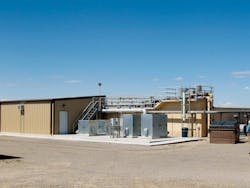Retrofit for Reuse
The Rio Del Oro Wastewater Treatment Plant, located in Los Lunas, N.M., is owned and operated by private utility New Mexico Water Services Co. In 2005, New Mexico Water began the upgrade of the 100,000-gal-per-day (gpd), single-train conventional activated sludge (CAS) system with an Enviroquip membrane bioreactor (MBR) system to meet Class 1A effluent for reuse.
Using flat-plate membrane technology allows for an 800% expansion of this facility without building any new tankage. The retrofit was estimated to be about half the cost of using conventional technology. Total installed cost for Phase I of the retrofit (200,000 gpd) was $1.3 million. It is estimated to cost an additional $700,000 to double the capacity again to 400,000 gpd.
The Approach
Because the New Mexico Environment Department would not approve a variance during construction, the existing facility had to remain in operation and still meet permit limits during the retrofit. The facility was able to take down the aeration basin and divert the flow to the emergency storage basin for three days. During those three days, a temporary MBR system was installed in the aeration basin. Six submerged membrane units (SMUs) were dropped into the basin and piped up. Other than a membrane piping support structure, no new walls or dividers were required.
The temporary MBR stayed online for about six months while the secondary clarifier was partitioned into two MBR basins and one swing basin. This 32-ft-by-32-ft clarifier now holds two membrane basins (each with four SMUs) and one swing basin. Six of these units were reused from the temporary MBR basin. The aeration basin that was used for the temporary MBR was then converted into a digester. Two of the plant’s existing 50-hp blowers were reused for the digester. This configuration represents Phase I of the project and treats 200,000 gpd of wastewater to Class 1A reuse water. The effluent is pumped two miles
up the canyon to a holding pond where the Valley Improvement Assn., a nonprofit group, uses it to water the grass, landscaping and soccer fields of the Las Marivares Park and Veterans Park Soccer Complex. Visitors often fish in that pond, and occasionally a fishing tournament is held there. If the pond is full, the effluent is diverted to a natural riverbed, where it percolates into the ground.
Future Plans
Phase II includes installing eight more membrane units on top of the eight already there, and converting the existing pre-mix channel and chlorine contact basin into anoxic zones. Adding a couple of permeate pumps, recycle pumps and mixers will take the plant capacity to 400,000 gpd. To double the flow again to 800,000 gpd, the existing aeration basin will be converted to a duplicate image of the first MBR train. The existing plant, therefore, can increase in capacity by eight times and produce Class 1A reuse-quality water without building any new tanks.
Results
The MBR plant is operated by one full-time operator with a Class IV wastewater license. Although there is no separate anoxic zone in Phase I, the plant consistently produces effluent total nitrogen of 2 to 4 mg/L with only a swing basin.
The new MBR went online in June 2006 as the complete facility, and July 2006 brought the first MBR power bill. There was a power increase of about $1,900 per month. This increase can be attributed to several items:
- Increased capacity from 100,000 gpd to 200,000 gpd;
- Effluent permit went from 30/30 to Class 1A Reuse;
- MBR blowers sized for Phase II (0.4 million gal per day) and operating below their best efficiency point;
- Disinfection changed from chlorination to UV disinfection;
- Digester added (two 50-hp blowers for digester and two 60-hp for MBR); and
- Power rate increased.
The two 50-hp digester blowers operate 12 hours per day (30 minutes on/30 minutes off). The addition of the digester reduced hauling loads by at least half. Figure 1 shows the power trend for that three-year period.
Conclusion
A single-stage CAS system can be upgraded to a Class 1A reuse facility using MBR technology without a variance, and it can be done affordably. The total installed cost of this design-build was $1.3 million. Furthermore, a reuse MBR facility can be operated by only one full-time employee.
The plant now produces Class 1A reuse water and ultimately will provide up to eight times the original capacity. In October 2010, New Mexico Water began upgrading its old blowers with new positive displacement blowers. Electricity usage will be monitored and trended after the switch to determine what a more efficient MBR can do. Although New Mexico Water does not charge for its reuse water, it is estimated that it could be sold for approximately $0.50 per 1,000 gal. Potable water costs are $1.09 per 1,000 gal.
Download: Here
